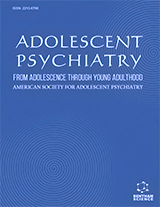Abstract
Aims: We aimed to document the clinical rates and correlates of problematic substance use among adolescent inpatients.
Background: Adolescents referred to psychiatric inpatient care are likely to present family and social risk factors making them at high risk of substance use disorder.
Objective: The objective of this study is to document the rates, clinical correlates, and effects of associated problematic substance use on therapeutic outcomes in adolescents referred to psychiatric inpatient care.
Methods: The DEP-ADO questionnaire was used to systematically screen out problematic substance use in two 12-18 adolescent inpatient units between January 2017 to December 2018. Inpatients who were screened positively based on the DEP-ADO questionnaire and/or information gathered from repeated interviews with the youths and their families were reported to the liaison addiction unit for diagnosis. The chart-review procedure was used to document clinical correlates (i.e., suicidal behavior, DSM-5 psychiatric diagnoses, the Clinical Global Impression-Severity score) and therapeutic outcomes (i.e., the Clinical Global Impression- Improvement score, change in Children-Global Assessment Scale score during patients’ stay and length of stay).
Results: Over two years, 150 adolescents completed the DEP-ADO questionnaire (Mean Age =14.7 ± 1.7; 42% girls). Thirty percent of adolescent inpatients reported some type of problematic substance use, with a higher likelihood of daily tobacco use (OR=2.4), regular cannabis use (OR=2.3), and occasional opioid/heroin use (OR=9.8) compared to the general population. Adolescent inpatients who misused illegal substances prior to admission were 2.5 times more likely to report suicidal behaviors. A strong association was reported between binge drinking behavior and a discharge diagnosis of bipolar disorder (OR=11.0). Therapeutic outcomes were not statistically different with regards to alcohol or illicit substance use status.
Conclusion: Inpatient adolescents were at high risk of associated problematic substance use. Patients with co-existing problematic substance use seem to have more severe and chronic forms of mood disturbances, although the response rate to therapeutics provided during their stay was not found to be lower compared to their counterparts without problematic substance use.
Keywords: Substance use, alcohol use, binge drinking, adolescent inpatient, dual disorders, substance abuse.
Adolescent Psychiatry
Title:Problematic Substance Use in Adolescent Psychiatric Inpatients: Rates, Clinical Correlates and Effects on Therapeutic Outcomes
Volume: 11 Issue: 3
Author(s): Xavier Benarous*, Pierre Morales , Cora Cravero, Barbara Jakubowicz, Nadège Bourvis , David Cohen and Yves Edel
Affiliation:
- Department of Child and Adolescent Psychopathology, Amiens University Hospital, Amiens,France
- INSERM Unit U1105 Research Group for Analysis of the Multimodal Cerebral Function, University of Picardy Jules Verne (UPJV), Amiens, France
Keywords: Substance use, alcohol use, binge drinking, adolescent inpatient, dual disorders, substance abuse.
Abstract: Aims: We aimed to document the clinical rates and correlates of problematic substance use among adolescent inpatients.
Background: Adolescents referred to psychiatric inpatient care are likely to present family and social risk factors making them at high risk of substance use disorder.
Objective: The objective of this study is to document the rates, clinical correlates, and effects of associated problematic substance use on therapeutic outcomes in adolescents referred to psychiatric inpatient care.
Methods: The DEP-ADO questionnaire was used to systematically screen out problematic substance use in two 12-18 adolescent inpatient units between January 2017 to December 2018. Inpatients who were screened positively based on the DEP-ADO questionnaire and/or information gathered from repeated interviews with the youths and their families were reported to the liaison addiction unit for diagnosis. The chart-review procedure was used to document clinical correlates (i.e., suicidal behavior, DSM-5 psychiatric diagnoses, the Clinical Global Impression-Severity score) and therapeutic outcomes (i.e., the Clinical Global Impression- Improvement score, change in Children-Global Assessment Scale score during patients’ stay and length of stay).
Results: Over two years, 150 adolescents completed the DEP-ADO questionnaire (Mean Age =14.7 ± 1.7; 42% girls). Thirty percent of adolescent inpatients reported some type of problematic substance use, with a higher likelihood of daily tobacco use (OR=2.4), regular cannabis use (OR=2.3), and occasional opioid/heroin use (OR=9.8) compared to the general population. Adolescent inpatients who misused illegal substances prior to admission were 2.5 times more likely to report suicidal behaviors. A strong association was reported between binge drinking behavior and a discharge diagnosis of bipolar disorder (OR=11.0). Therapeutic outcomes were not statistically different with regards to alcohol or illicit substance use status.
Conclusion: Inpatient adolescents were at high risk of associated problematic substance use. Patients with co-existing problematic substance use seem to have more severe and chronic forms of mood disturbances, although the response rate to therapeutics provided during their stay was not found to be lower compared to their counterparts without problematic substance use.
Export Options
About this article
Cite this article as:
Benarous Xavier *, Morales Pierre , Cravero Cora , Jakubowicz Barbara , Bourvis Nadège, Cohen David and Edel Yves , Problematic Substance Use in Adolescent Psychiatric Inpatients: Rates, Clinical Correlates and Effects on Therapeutic Outcomes, Adolescent Psychiatry 2021; 11 (3) . https://dx.doi.org/10.2174/2210676611666211105115828
| DOI https://dx.doi.org/10.2174/2210676611666211105115828 |
Print ISSN 2210-6766 |
| Publisher Name Bentham Science Publisher |
Online ISSN 2210-6774 |
 13
13
- Author Guidelines
- Bentham Author Support Services (BASS)
- Graphical Abstracts
- Fabricating and Stating False Information
- Research Misconduct
- Post Publication Discussions and Corrections
- Publishing Ethics and Rectitude
- Increase Visibility of Your Article
- Archiving Policies
- Peer Review Workflow
- Order Your Article Before Print
- Promote Your Article
- Manuscript Transfer Facility
- Editorial Policies
- Allegations from Whistleblowers
- Announcements



























